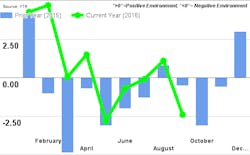The Good, the Bad and the Trump Plan: Freight Recovery Could Go Either Way
As predicted, conditions for shippers took a decidedly negative turn this past September, according to transportation forecasting firm FTR’s Shippers Conditions Index (SCI). The index fell three points from August to a -2.4 reading in September. As FTR points out, the August positive reading wasn’t expected to be much more than a temporary blip, which September’s drop confirms.
The Shippers Conditions Index is a compilation of factors affecting the shippers transport environment. Any reading below zero indicates a less-than-ideal environment for shippers. Readings below -10 signal conditions for shippers are approaching critical levels, based on available capacity and expected costs.
“While the Shippers Condition Index moved into negative territory, we are not seeing any material changes to shippers at the moment,” says Eric Starks, chairman and CEO of FTR. “There is still plenty of truck and rail capacity, and rates remain stable. We don’t anticipate any ‘real’ changes for shippers until late in Q1 or Q2 of next year. The shipping season is winding down, and demand for shipping will be in a seasonally soft period for the next few months.”
The decline in shipping conditions will continue to worsen until late 2017 at the earliest, due to new regulations that are tightening capacity and sending truck rates higher and higher, Starks notes. One wildcard that could change things, however, is the election of Donald Trump as U.S. President.
“One item that we are keenly focused on is the implementation of electronic logging devices by the trucking industry over the next year. If regulatory changes delay this, then it would not tighten truck capacity in the second half of next year as is currently anticipated. Only time will tell.”
Speaking of President-elect Trump, Donald Broughton, senior transportation analyst with Avondale Partners, points to Trump’s “Contract with the American Voter” manifesto, released two weeks before the election, where Trump outlined his plans for the first 100 days of his presidency. “The extent to which Trump’s initiatives could lead to higher rates of economic growth and larger volumes of freight flowing through the U.S. economy will depend upon which of the initiatives are (or are not) enacted and to what extent they are enacted,” Broughton observes.
Broughton, who provides analysis for the monthly Cass Freight Index provided by Cass Information Systems, notes that for the month of October, shipments were up on a year-over-year basis for the first time in nearly two years. He attributes this growth in part to an increase in parcel and airfreight volumes driven by e-commerce.
“Although it is far too early to make a ‘change in trend’ call, data is beginning to suggest that the consumer is finally starting to spend a little and that the industrial economy’s rate of deceleration has eased,” he says. “Simply put, the winter of the overall freight recession we have seen for over a year and a half in the U.S. may not be over, but it is showing signs of thawing.”
Trump photo by Chip Somodevilla, Getty Images.

